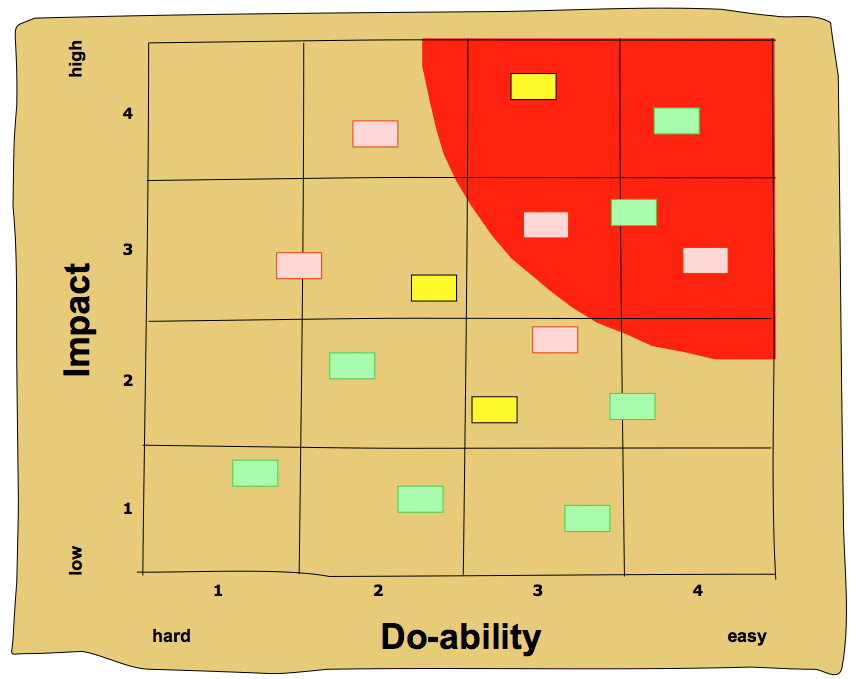Prioritization Matrix is a fun collaborative prioritization tool to compare the relative merits of alternative actions visually.
This is an extremely powerful activity which combines brainstorming, team building and action planning. It's one that I often use with teams as the conversation is always extremely fruitful.
Objectives
- To prioritize the relative merits of alternative actions using a visual tool.
- To help shortlist the best candidates to take forward.
- To quickly generate consensus among a group of people on what should be considered a priority.
When Would You Use It?
- Whenever you need to shortlist and prioritize a large number of items – ideas, opportunities or solutions.
- Best results with small to medium sized groups (no more than 10).
Are There Any Rules?
- Do a quick evaluation initially (i.e. don’t debate).
- Remember that all ratings are relative and not absolute.
- Moderate your evaluations once all the alternatives have been rated.
- Draw the prioritization segment last of all.
- Always try and Action Plan at the end.
Resources Required
- A willing group of people (max 10 for best results).
- A large square piece of blank paper big enough for everyone to stand around and see comfortably (1m by 1m is normally enough).
- Wall space to put the paper up on.
- A private quiet open space surrounding the paper.
- Post-it notes and lots of marker pens (at least one each plus a few extra spares if required).
- No tables and chairs – this is a standing high-energy exercise.
Process
-
The Facilitator explains the business objectives of the process (i.e. what is it we’re looking to achieve).
-
The Team brainstorms all candidates for action but does not put them on the chart yet.
-
The Team rates each one according to:
- Impact (if we did this what favorable impact would it have on fulfilling our objective? 1=Low, 4=High)
- Do-ability (how easy would this be to do? 1=Hard, 4=Easy)
-
The Team places each on the chart according to their scores and moderates their relative positioning to arrive at a sensible distribution.
-
The Facilitator then draws the prioritization sector in the top right of the matrix (everything inside this should be both impactful and easy to do).
-
Action Planning time!
Tips for the Phases
Brainstorm phase
- Use post-it notes to represent each item.
- The person who has the idea must write their own post-it as that increases ownership over the idea.
Prioritization phase
- Take each post-it note in turn and use the Team to rate the item in terms of Impact (1=Low, 4=High) and Do-ability (1=Hard, 4=Easy).
- Limit debate by driving for a quick consensus.
- The ideal outcome is to have items distributed across the matrix so that only a very small number appear in the top-right.
Most favorable options
- Shortlist to a manageable number of items by drawing a suitably scaled sector in the top right of the Matrix.
- Reducing the scale of the sector ensures that it embraces only the number of items you are looking to pursue.
Action planning

- The Facilitator asks everyone to develop a high level action plan for the highest priority items.
- Work quickly in brainstorm mode; try not to get stuck in discussion.
- Ensure that actions are assigned to increase ownership for the solution.
- Each action should be allocated a date by which it should be completed.
- Actions need not be captured in strict sequence as this will constrain the brainstorming process.
- At the end the Facilitator should thank the Team for their input (and resulting commitment!).
How to prioritize issues rather than solutions
- It’s quite possible to use the same process for prioritizing issues too by replacing ‘Do-ability’ for ‘Desirability’ (i.e. how compelling is the desire for change?)
- We must distinguish clearly between impact and desirability – they are different. The danger is to consider them as the same thing (i.e. anything with high impact must be desirable, while anything with low impact is not). This misses the point as Impact reflects the rational side of change, while desirability reflects the emotional and political elements. Distinguish between them as follows:
- For any change to be successful there must be a good reason to do it. Typically this means there must be some favorable impact on something as a result. This deals with the rational side of change.
- However, you fool yourself if you think that favorable impact alone is sufficient to succeed in executing change. There are plenty of examples where change doesn’t happen despite the promise of a positive outcome. Typically this is because people are resistant to change, skeptical or simply too ‘busy’ to get involved. It is easier to implement change where the stakeholders involved actually want to change things for the better, so let’s use desire as the second criterion. This addresses the emotional and political elements of change.

Here's an example of a completed matrix
Secret Sauce
- It is advantageous to draw in the prioritization sector only at the last stage rather than at the beginning. A sector drawn at the outset will only tempt people to rate all items so that they fall within the sector!
- For a more elaborate and systematic way of rating Do-ability the Team can:
- Breakdown the Do-ability criterion into its component parts (cost, effort and risk).
- Agree on the relative weighting of each in % terms.
- Rate the items on each component.
- Total the product of rating x weighting (see table in the free download).
- Transfer to chart.

